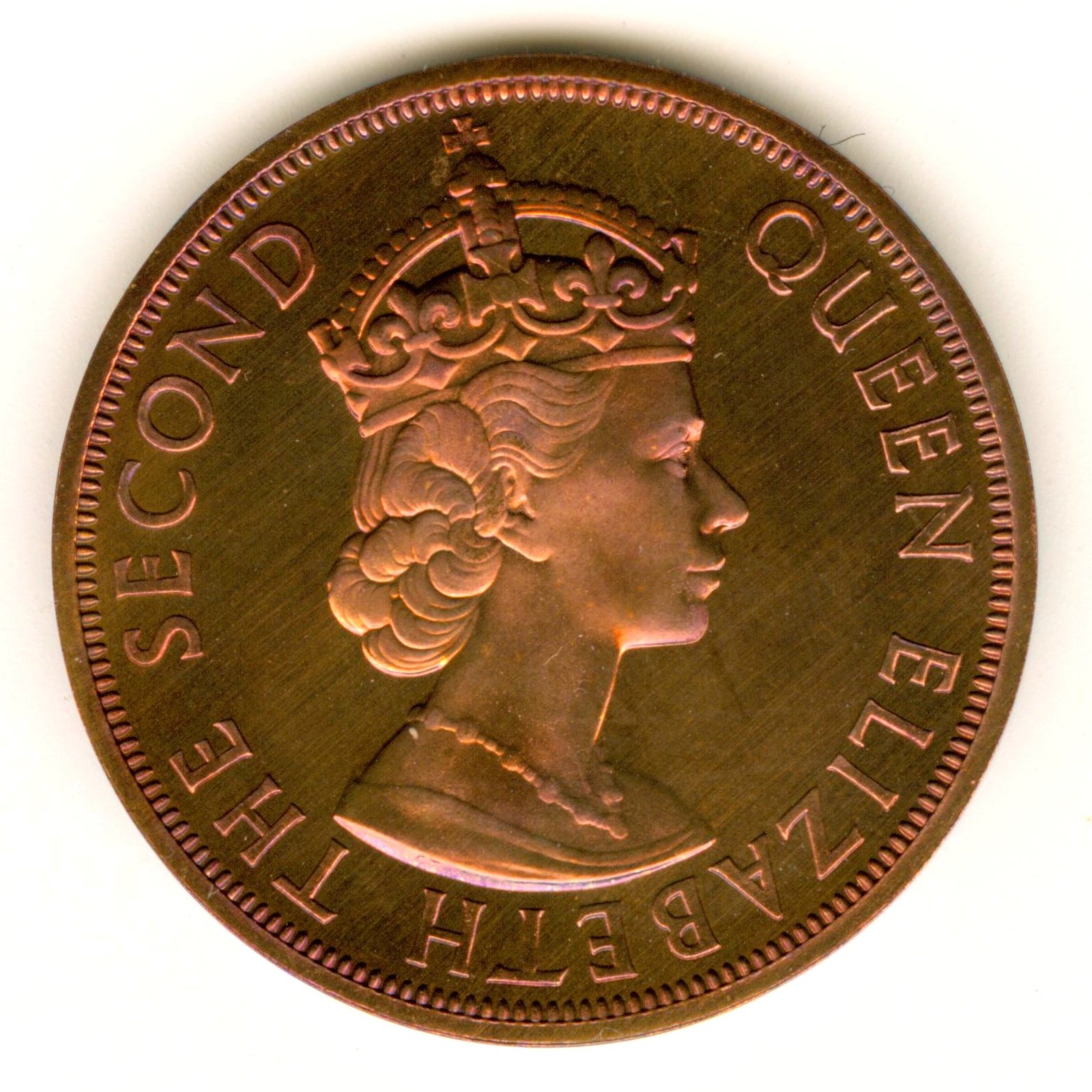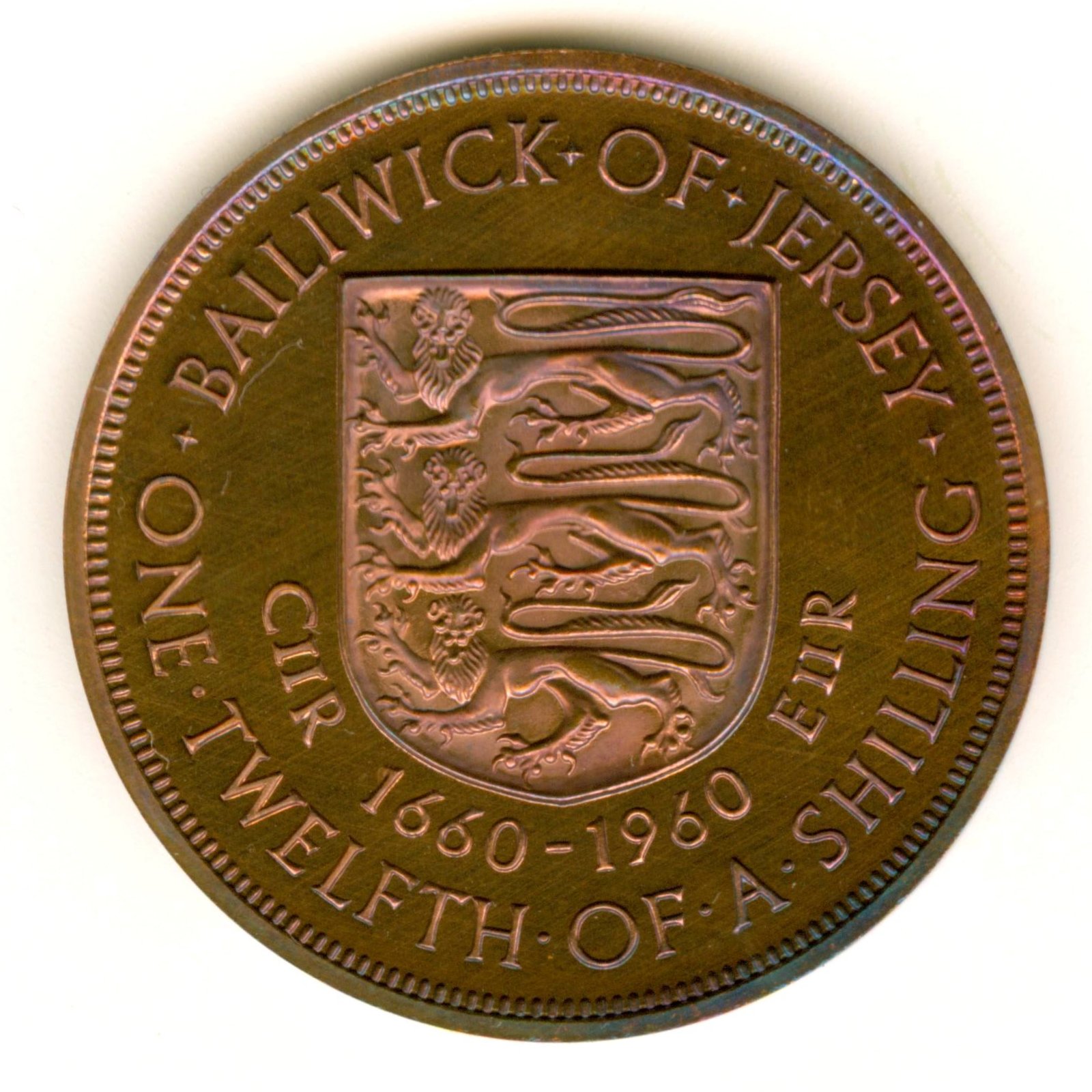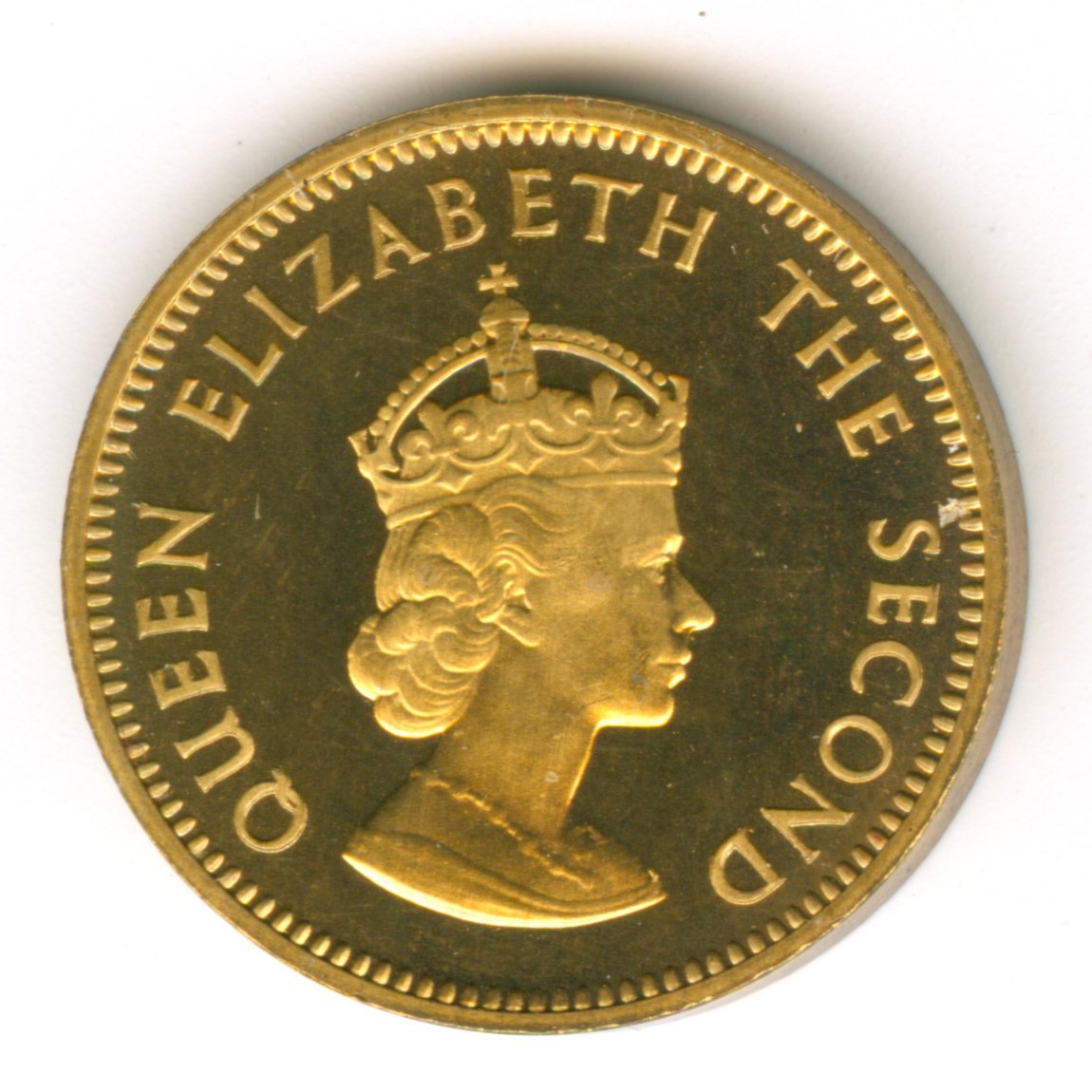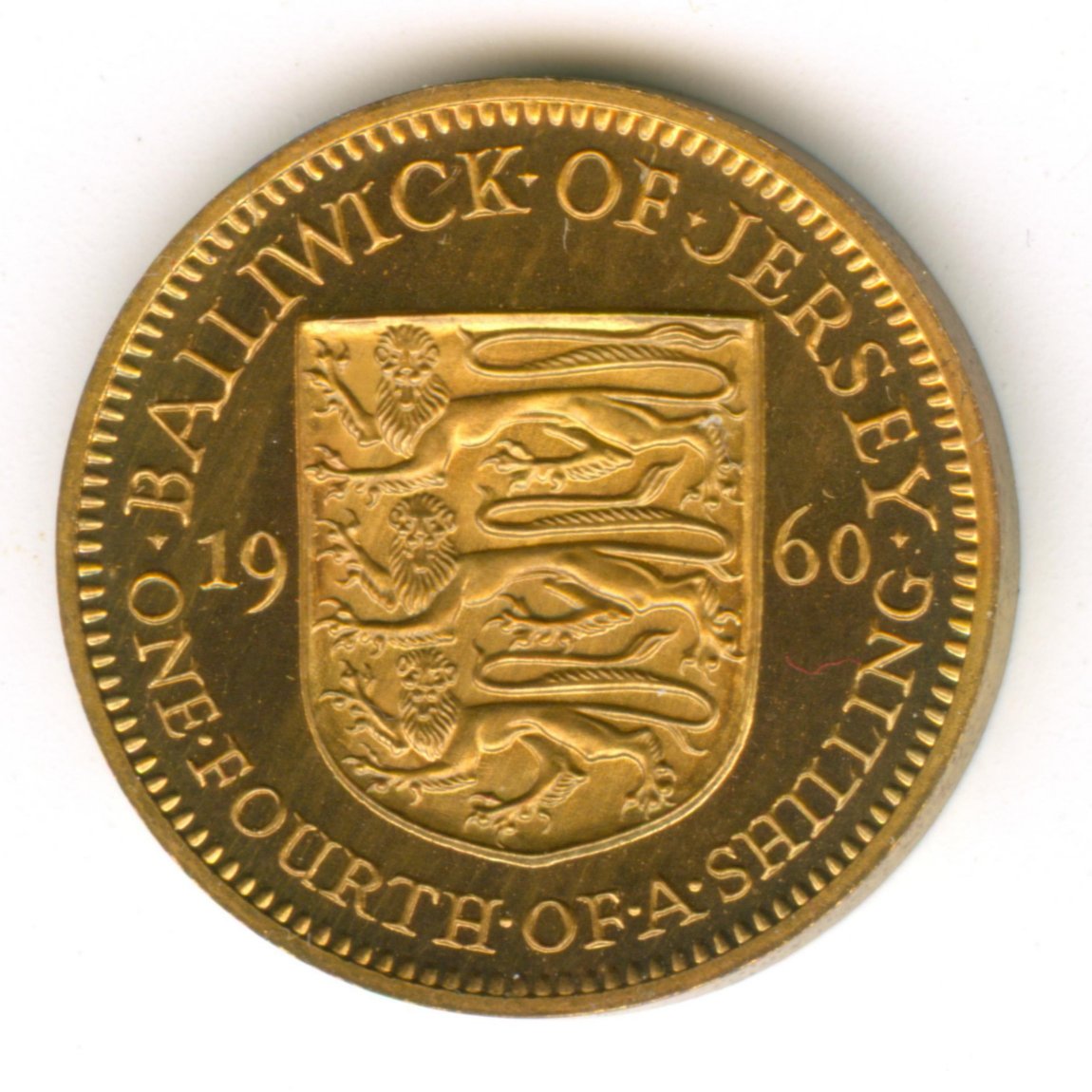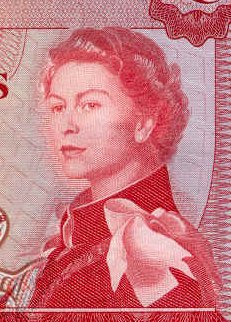
Isle of Man, Malta, Rhodesia, Trinidad and Tobago, Seychelles,
East Caribbean States, Mauritius, and Fiji used this portrait
on their banknotes too.
 |
This portrait of the Queen is adapted from a painting by Pietro Annigoni
and can be found on the banknotes issued during the 1960s.
The portrait is regarded by many as one of the finest portrayals of the young Queen. Isle of Man, Malta, Rhodesia, Trinidad and Tobago, Seychelles, East Caribbean States, Mauritius, and Fiji used this portrait on their banknotes too. |
|
The New Coinage for Other Parts of the Commonwealth and Empire
from the Royal Mint Annual Report 1953 Volume No.84 |
|---|
|
Coins bearing the Queen's Effigy were struck for the following parts of the Commonwealth and Empire during the year.
Uncrowned Effigy: New Zealand and Southern Rhodesia. Crowned Effigy: Fiji, Jamaica, Malaya, Mauritius, Seychelles It has become well established practice that coins bearing the crowned effigy of the Sovereign shall not be issued before that Sovereign's Coronation. Accordingly, coins on order from British East Africa, and British West Africa, due In whole or in part for despatch before 2nd June 1953, bore the Crowned Effigy of His Late Majesty, and the date 1952. In the past, there have been a variety of inscriptions on the coins of the various Dependent Territories. For example, at the end of the reign of His-Majesty King George VI, although the coins of most Territories bore the inscription "KING GEORGE THE SIXTH", the coins of Cyprus, British West Africa and East Africa did not follow the majority in this respect. Indeed, the inscription on the perforated coins of British West Africa was different from that on the coins bearing the crowned Effigy. Investigation showed that there was little reason for this variation in present circumstances, and Her Majesty therefore approved the suggestion that all the coins of the new Reign in the Dependent Territories should have the inscription "QUEEN ELIZABETH THE SECOND". It was subsequently agreed that the same inscription should be used on the coins of Jersey, which bear a crowned Effigy. |
 Be sure to click on the letter icon
Be sure to click on the letter icon  to see images using a digital microscope.
to see images using a digital microscope.
| One Twelfth of a Shilling 1945 Liberation Commemorative (click on image to enlarge) | |
|---|---|
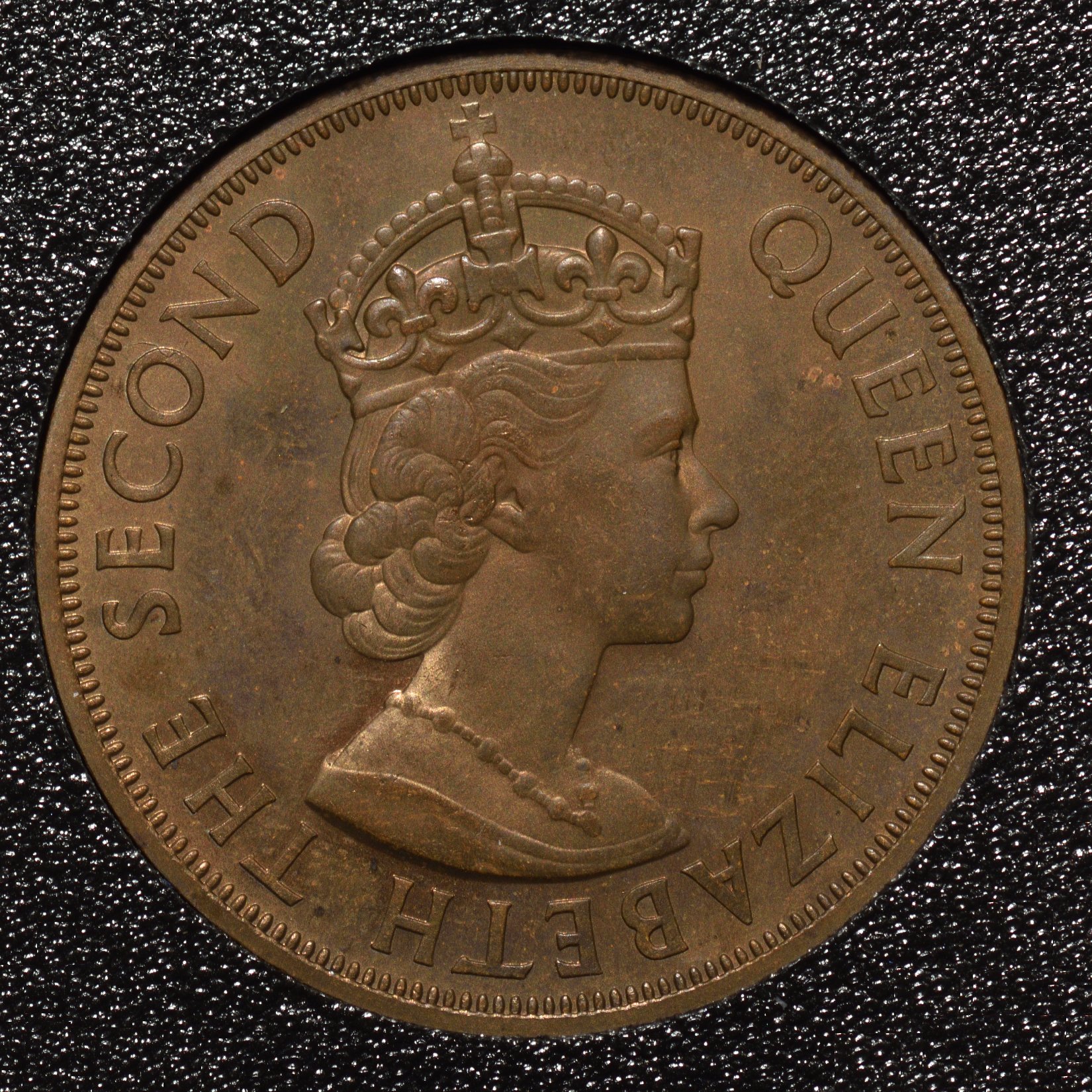 |
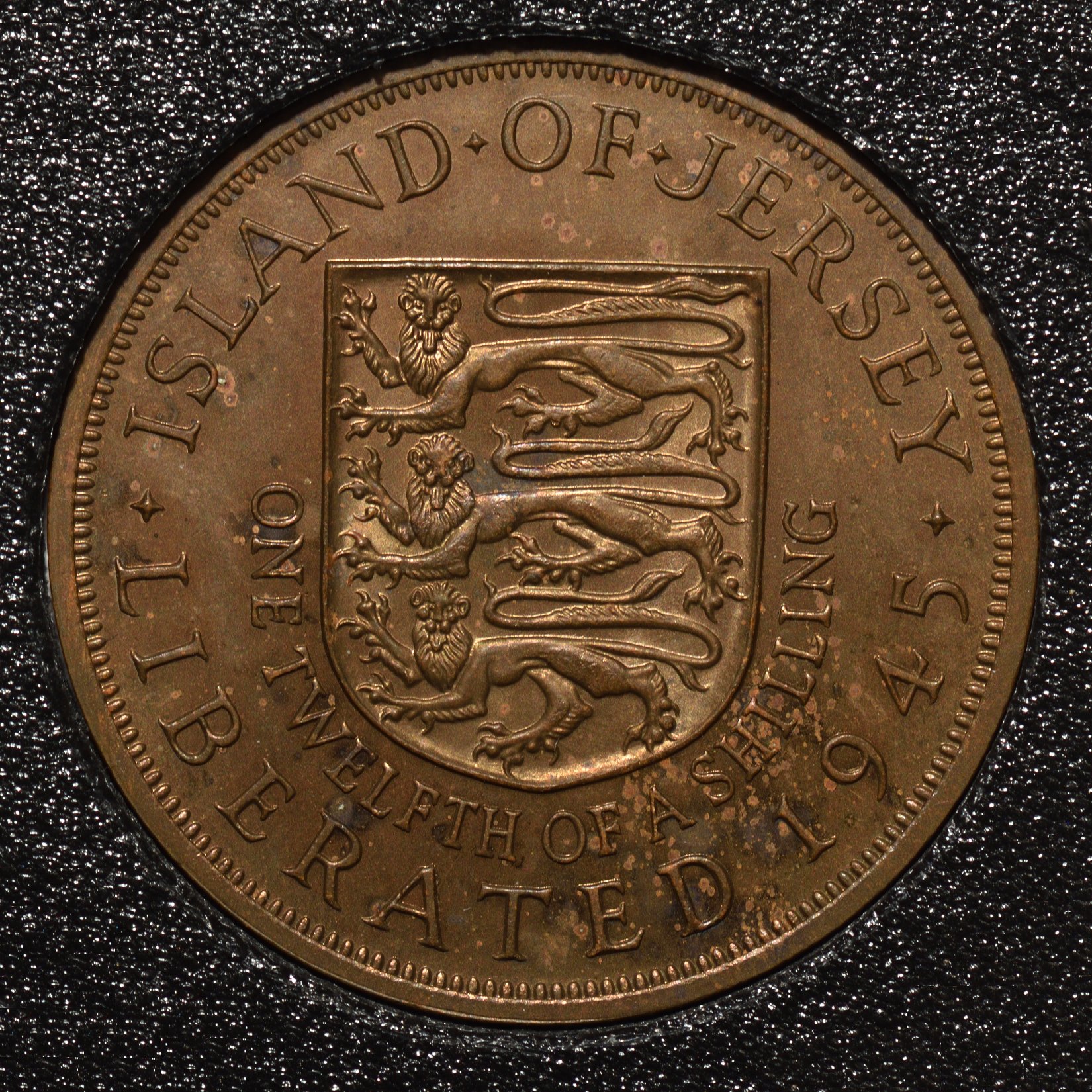 |
Year J# KM# Mintage Diameter
1945 29 20 720,000 30.80 

For the first coins depicting the new Queen, it was decided to continue using the same reverse as the previous coinage.
| One Twelfth of a Shilling 1957 and 1964 (click on image to enlarge) | |
|---|---|
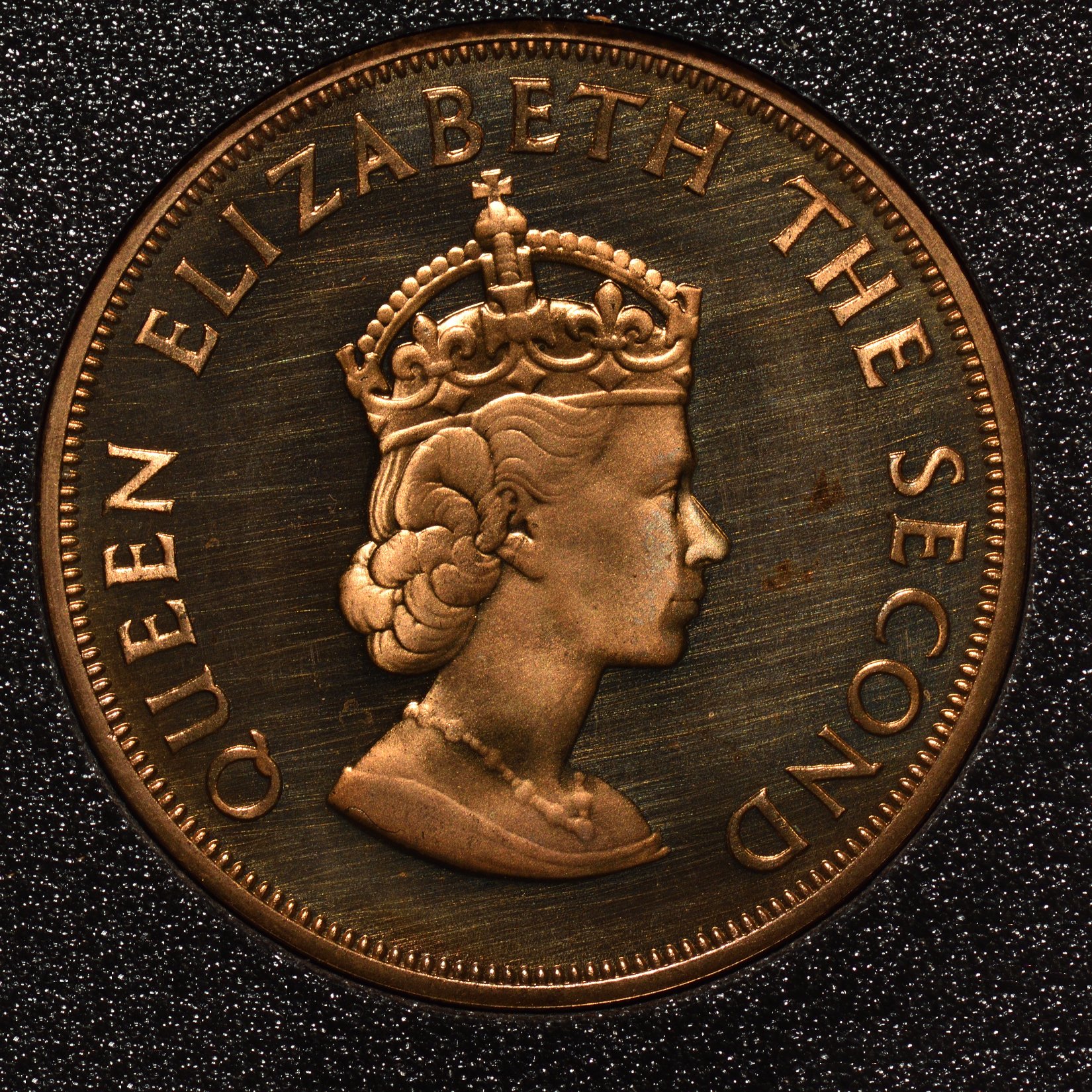 |
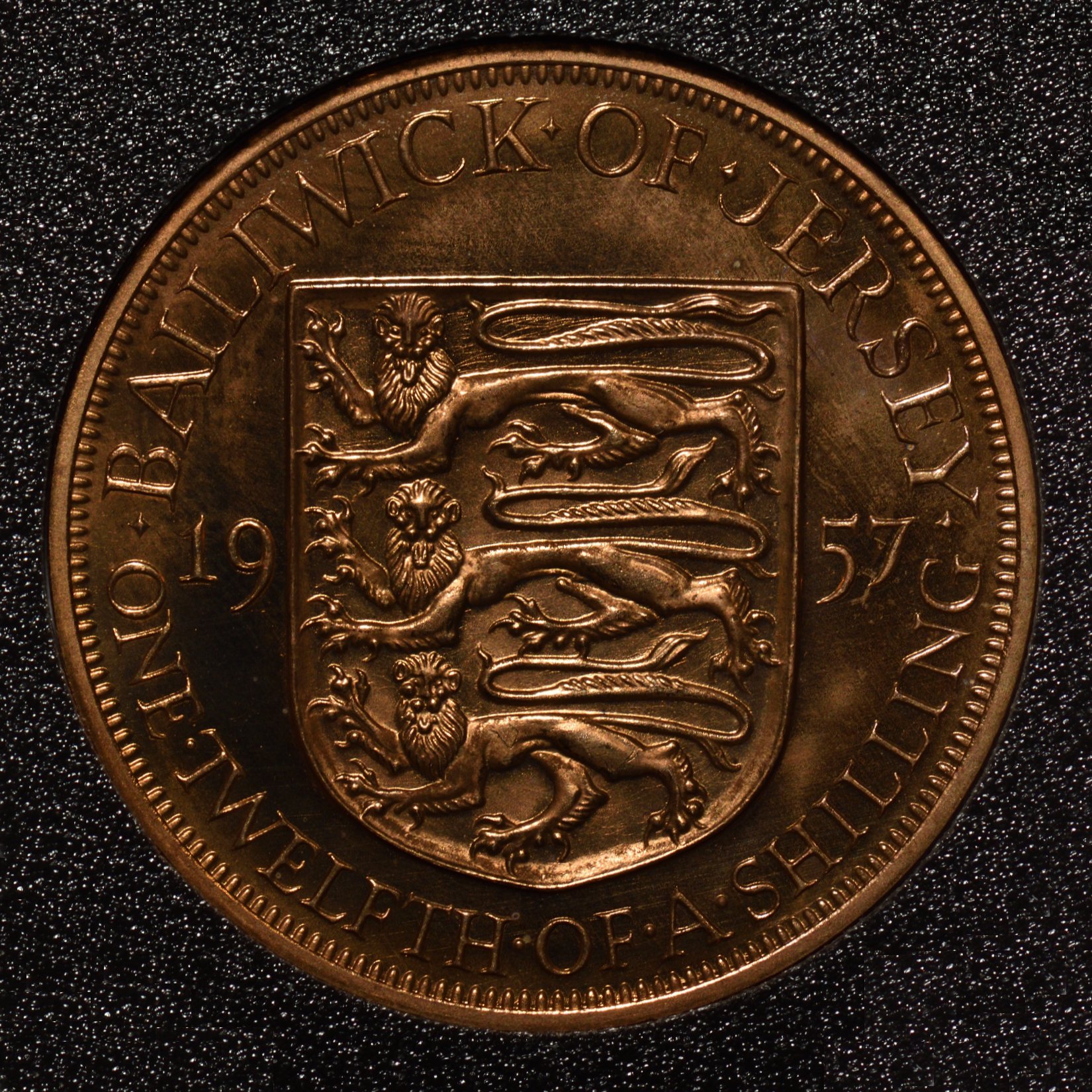 |
Year J# KM# Mintage Diameter
1957 30 21 720,000 30.80 
 1964 32 1,200,000 30.80
1964 32 1,200,000 30.80 

In 1957 the coinage was re-designed with a couple of minor but important changes.
Since there were adverse comments on the Queen's name appearing upside down,
the effigy is now smaller and moved downward, while the legend is now centered around the top.
For the reverse, the title of the Island is now “THE BAILIWICK OF JERSEY.”
| One Twelfth of a Shilling 1960 300th Anniversary of Accession of King Charles II (click on image to enlarge) | |
|---|---|
 |
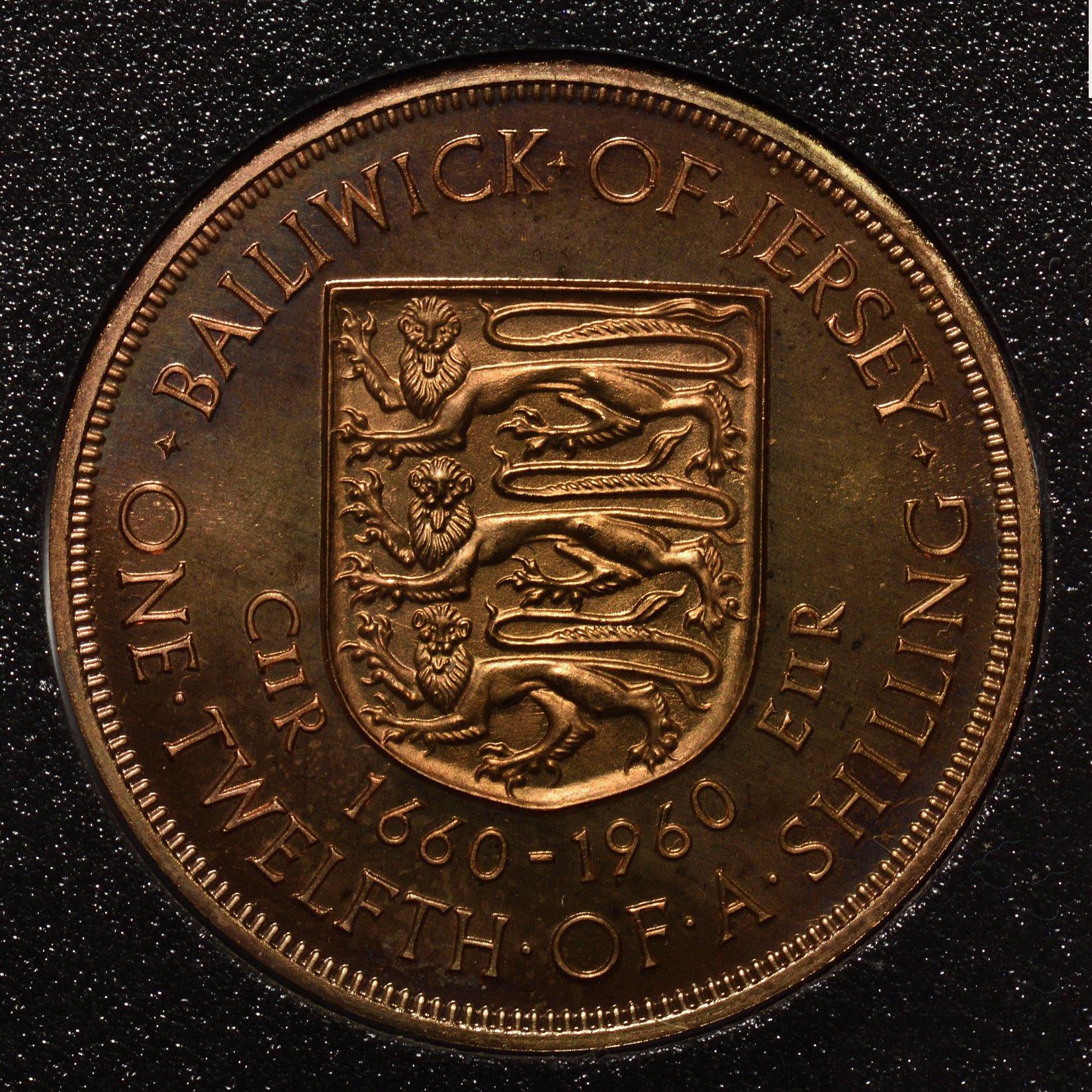 |
Year J# KM# Mintage Diameter
1960 31 23 1,200,000 30.80 

After the execution of Charles I in 1649, Jersey was the first place to proclaim his son King Charles II.
(It was not until the end of the English Civil War in 1660, that he was actually crowned king in England.)
On November 28, 1663, King Charles II presented to the Bailiff of Jersey the Royal Mace
in gratitude for the loyalty and kindness
he received during his two stays on the Island during the Civil War.
The Royal Mace is considered by many as one of the finest maces of the 17th century.
It consists of 11 pieces and is made of silver gilt.
The mace is 4' 9.5" long and weighs over 237 ounces (14 pounds, 13 ounces).
This coin commemorates his stay in Jersey.
Two days before Charles left Jersey he issued an Order to establish a mint in the island. Four years earlier, when he had been here as Prince, an attempt had been made to do this, but the man put in charge had proved a rogue who turned out spurious money, and this effort had to be hurriedly suppressed and hushed up. But a King ought to have a coinage, and Jersey was the only part of his dominions that still acknowledged him; so on 11 February 1650 he issued detailed orders for the Mint to be re-established:Things to note:
|
| One Twelfth of a Shilling Obverse of the 1961 British Caribbean Territories Two Cents with the Reverse of the 1960 Jersey One Twelfth of a Shilling (click on image to enlarge) | |
|---|---|
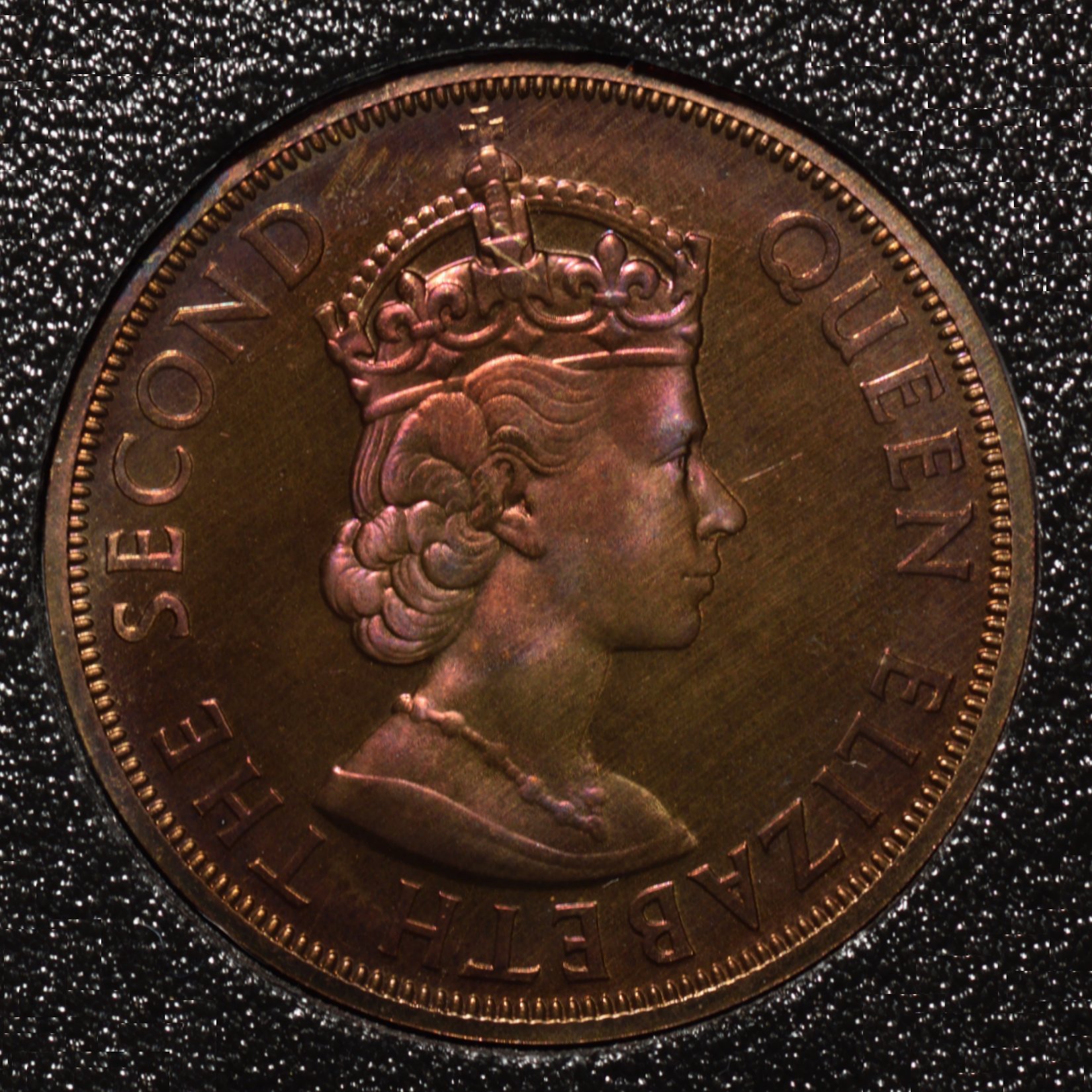 |
 |
Year J# KM# Mintage Diameter
1960 31B 24 ?? 30.80 
These coins were produced when the Royal Mint accidentally used a wrong obverse die when minting the 1960 proof sets.
At first glance, the incorrect die appears to be the one used on the 1945 Liberation issue.
However, the Royal Mint destroyed these dies when the new design was introduced in 1957.
The incorrect die is a British Caribbean Territories two cents die. The British Caribbean Territories
two cents coin was the only coin of the same size, weight and alloy of the Jersey penny and incidentally
had the inscription below the effigy.
Although proof specimens of the British Caribbean Territories
two cents coin and the Jersey penny were struck at the Royal Mint in each of the years 1961, 1962, and 1963,
there was only one time, viz. from August the 8th through the 22nd, 1961 when obverse dies of both coins were held in the coin
processing room die store.5
Evidently it was during this time period when the Royal Mint manufactured eighteen two cents
proof coins for the Mint Museum, which this die was inadvertently used for the Jersey coins.
As for the number of coins produce, an exact number is impossible to determine.
However, it would be reasonable to assume that some coins were produced after August 22 and until late September when the order was completed.
Also, we can assume that some coins were produced before August 8 and that striking continued concurrently
with the striking of the Caribbean two cents coins.
These mule coins are a tiny sub-set of the total mintage and thus, this coin is a modern rarity.
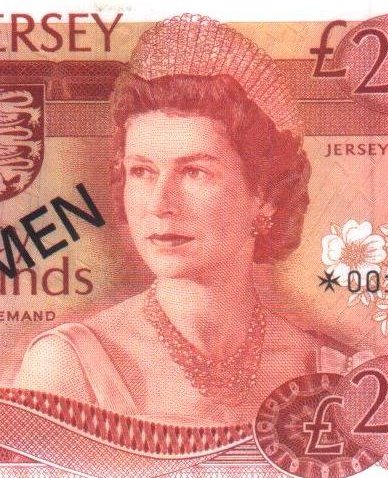 |
Jersey's second series of banknotes depicts this portrait of Her Majesty. This portrait of Her Majesty is adapted from a photograph taken prior to a Royal Tour of India and Pakistan. This is one of the more widely used images of The Queen. |
| A Letter from the Royal Mint Explaining the Problem |
|---|
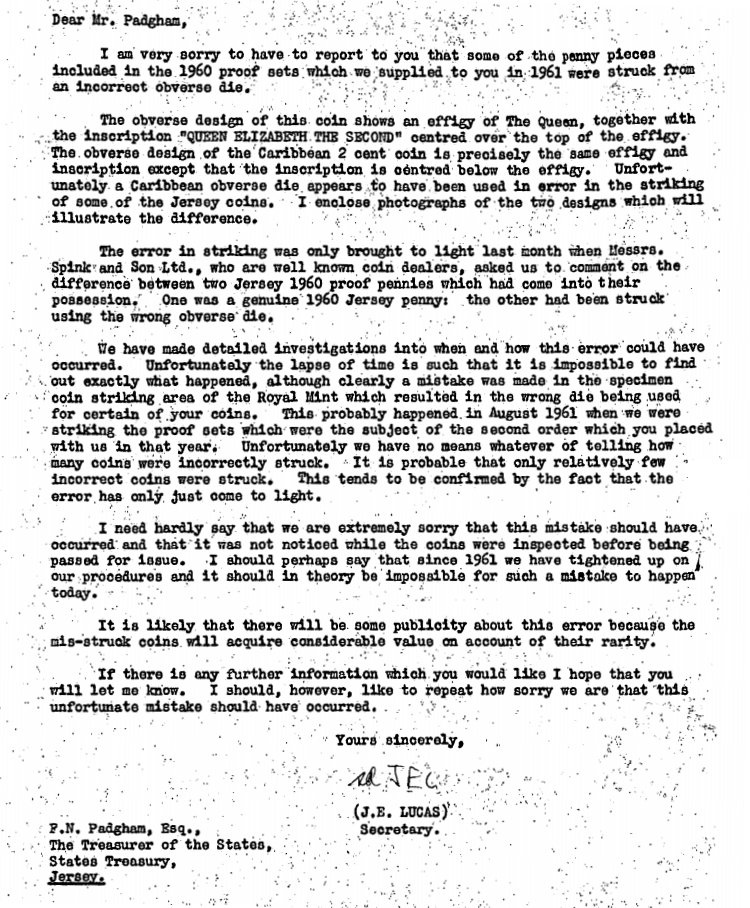
|
| One Twelfth of a Shilling 1966 Norman Conquest Commemorative (click on image to enlarge) | |
|---|---|
 |
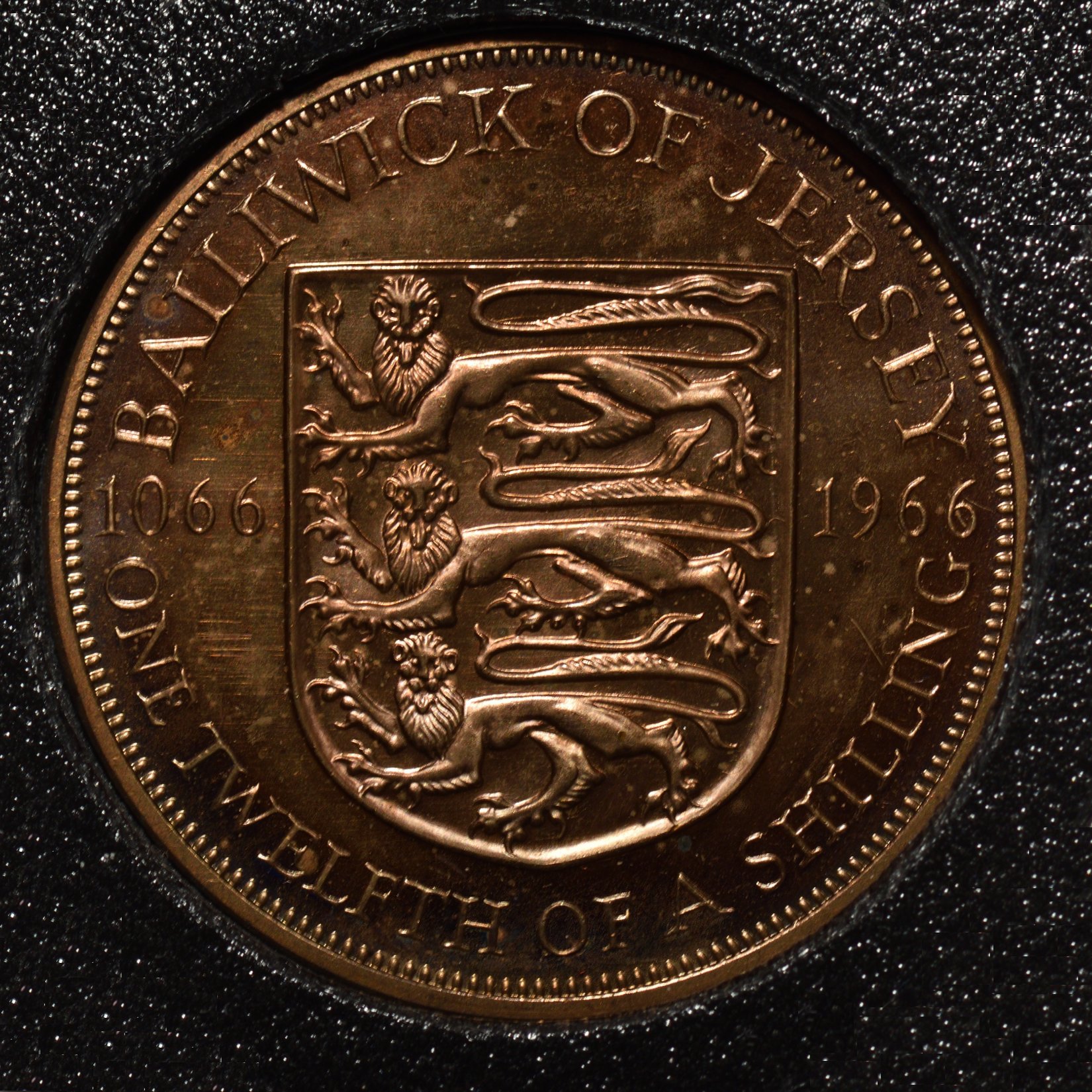 |
Year J# KM# Mintage Diameter
1966 33 26 1,200,000 30.80 

In 1966, Jersey celebrated the 900th anniversary of the Norman Conquest and
its unique links with England.
The Island has “peculiar” privileges obtained through a series of royal charters which has resulted in Jersey being officially known
in the constitutional terms as “A Peculiar of the Crown.”
In 1204, King John lost his lands in Normandy to the French but, Jersey and the other Channel Islands,
which were also part of the Duchy of Normandy, sided with the King and Jersey has remained predominantly royalist since that time.
These coins were minted to mark this special anniversary.
| One Twelfth of a Shilling Obverse of the 1966 Jersey One Twelfth of a Shilling the Reverse of the 1966 British Penny |
|
|---|---|
One example was sold as lot 124 in the Colin Cooke auction of The James Workman Superior Collection of Pennies Part 2 in November 2010. The coin received 10 bids and the hammer price was for £2100. |
| One Fourth of a Shilling 1957 and 1960 (click on image to enlarge) | |
|---|---|
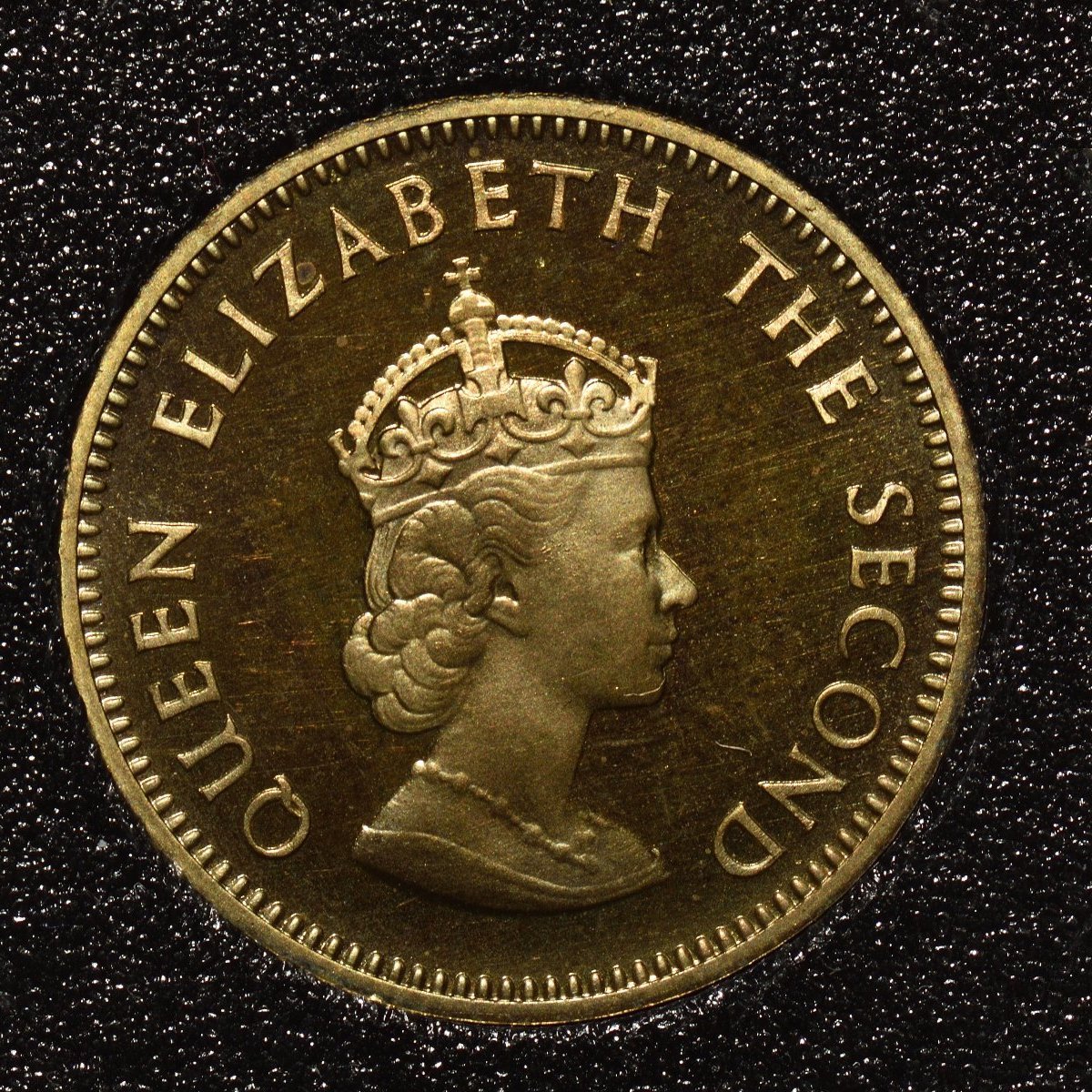 |
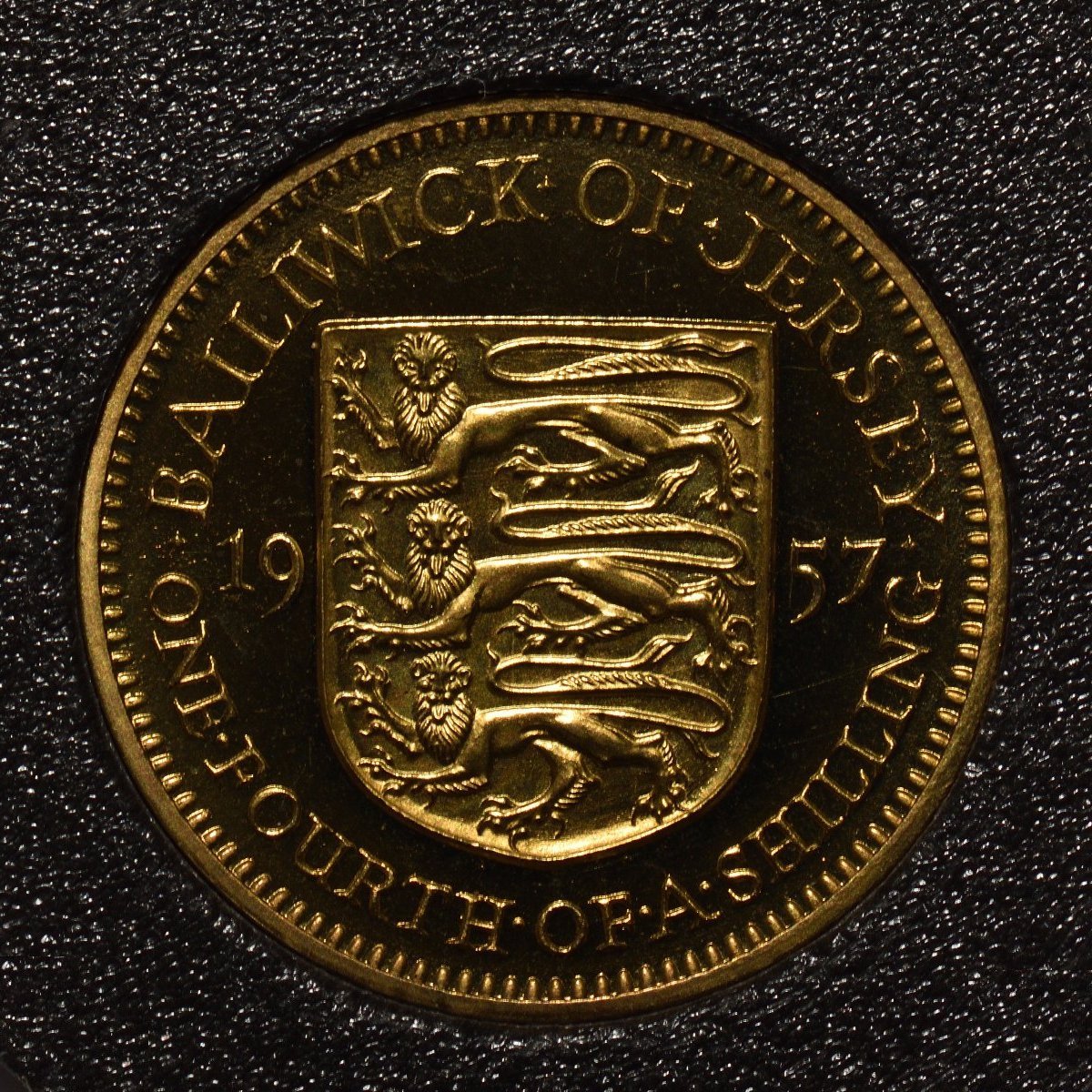 |
Year J# KM# Mintage Diameter
1957 60 22 2,000,000 21.05  1960 61A Proof 3,600
1960 61A Proof 3,600 
The reverse is an adaptation of Mr. Kruger Gray's design of 1931, showing a shield of arms with the inscription 'BAILIWICK OF JERSEY" with the date split with "19" on the left of the shield and "57"
on the right. The coin is nickel-brass with a plain edge.
Things to note:
| One Fourth of a Shilling 1964 (click on image to enlarge) | |
|---|---|
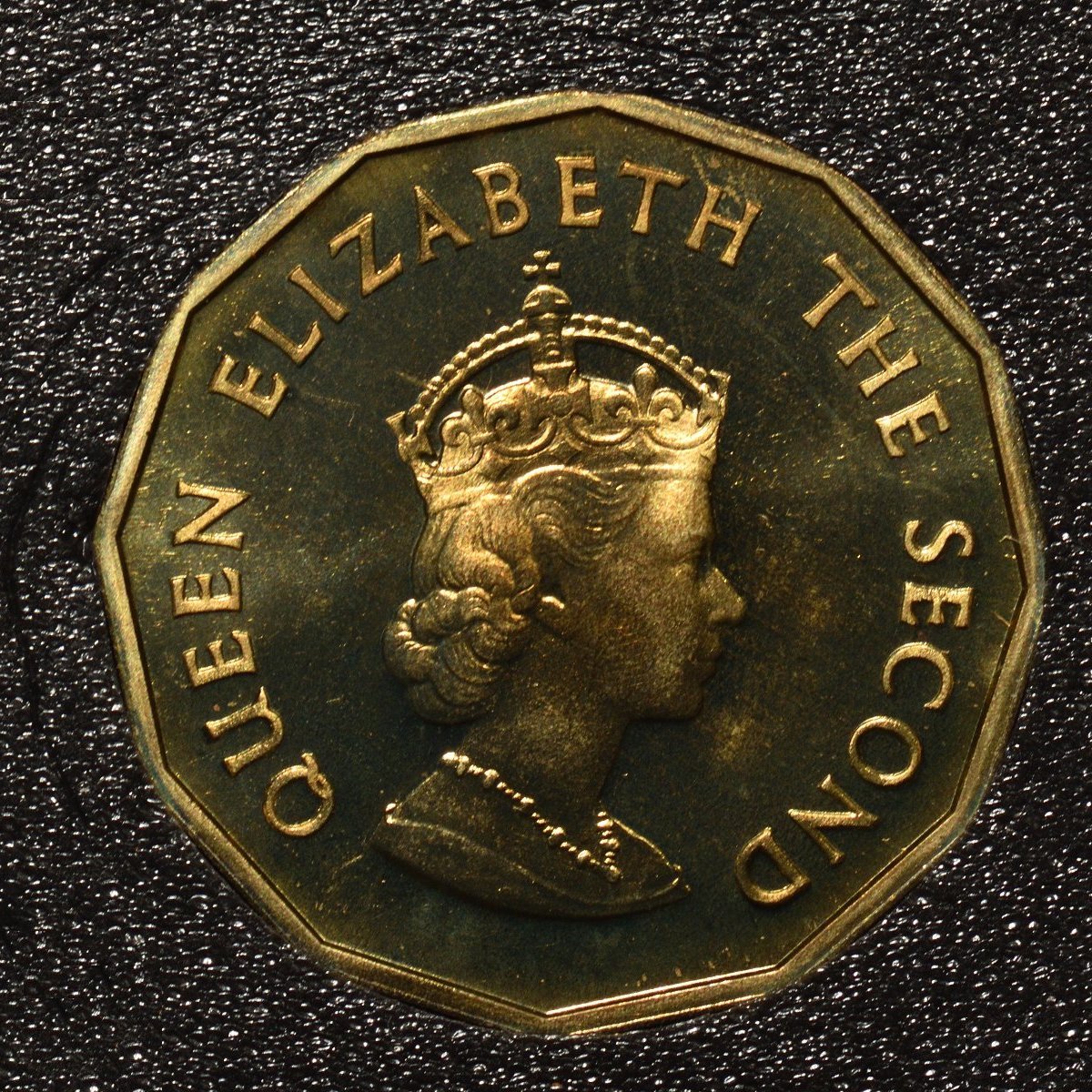 |
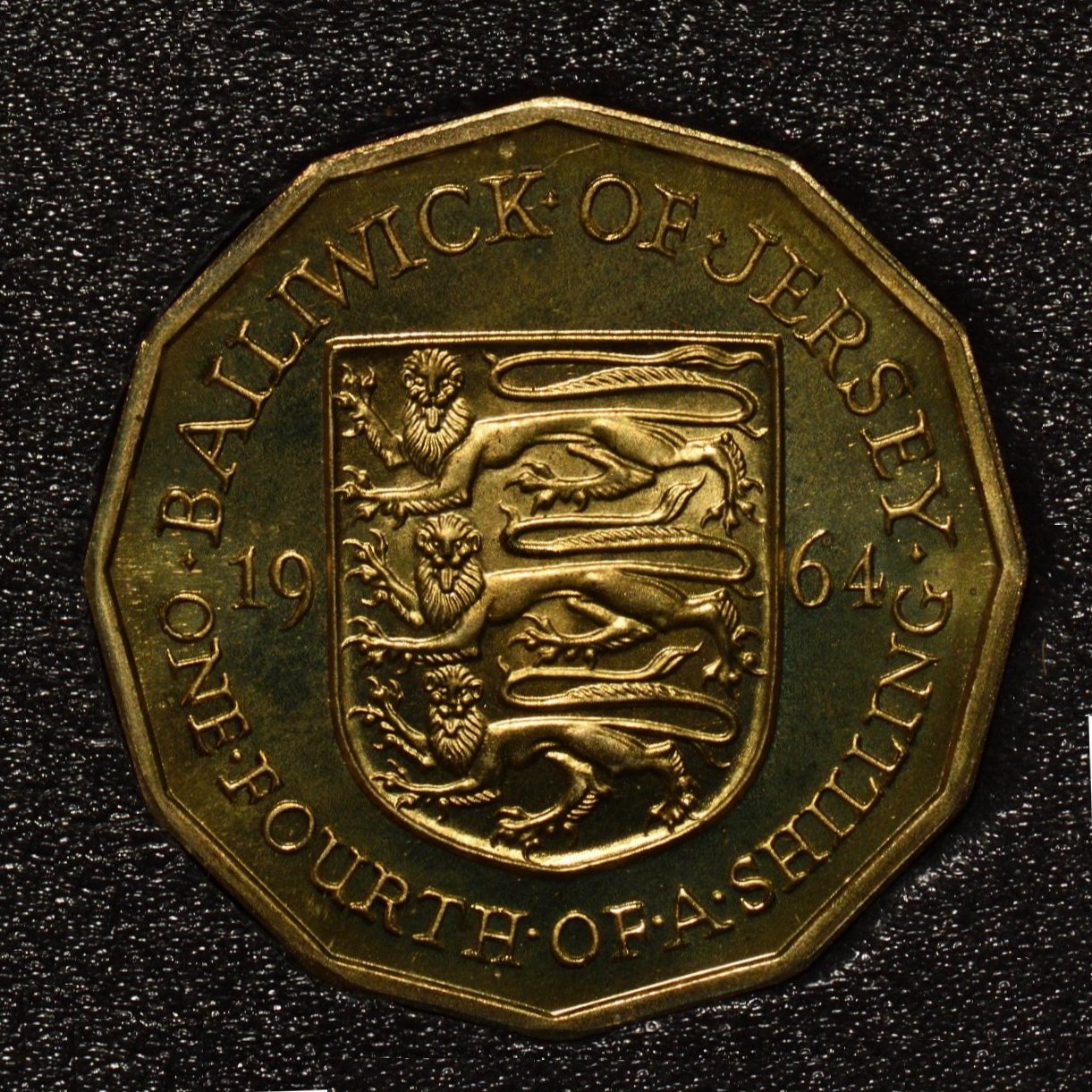 |
Year J# KM# Mintage Diameter
1964 62 25 1,200,000 21.10 
New matrices were prepared from preparing punches of the former circular design. The duodecagonal shape was machine-engraved on the matrices and working punches and dies produced.
| One Fourth of a Shilling 1966 Norman Conquest Commemorative (click on image to enlarge) | |
|---|---|
 |
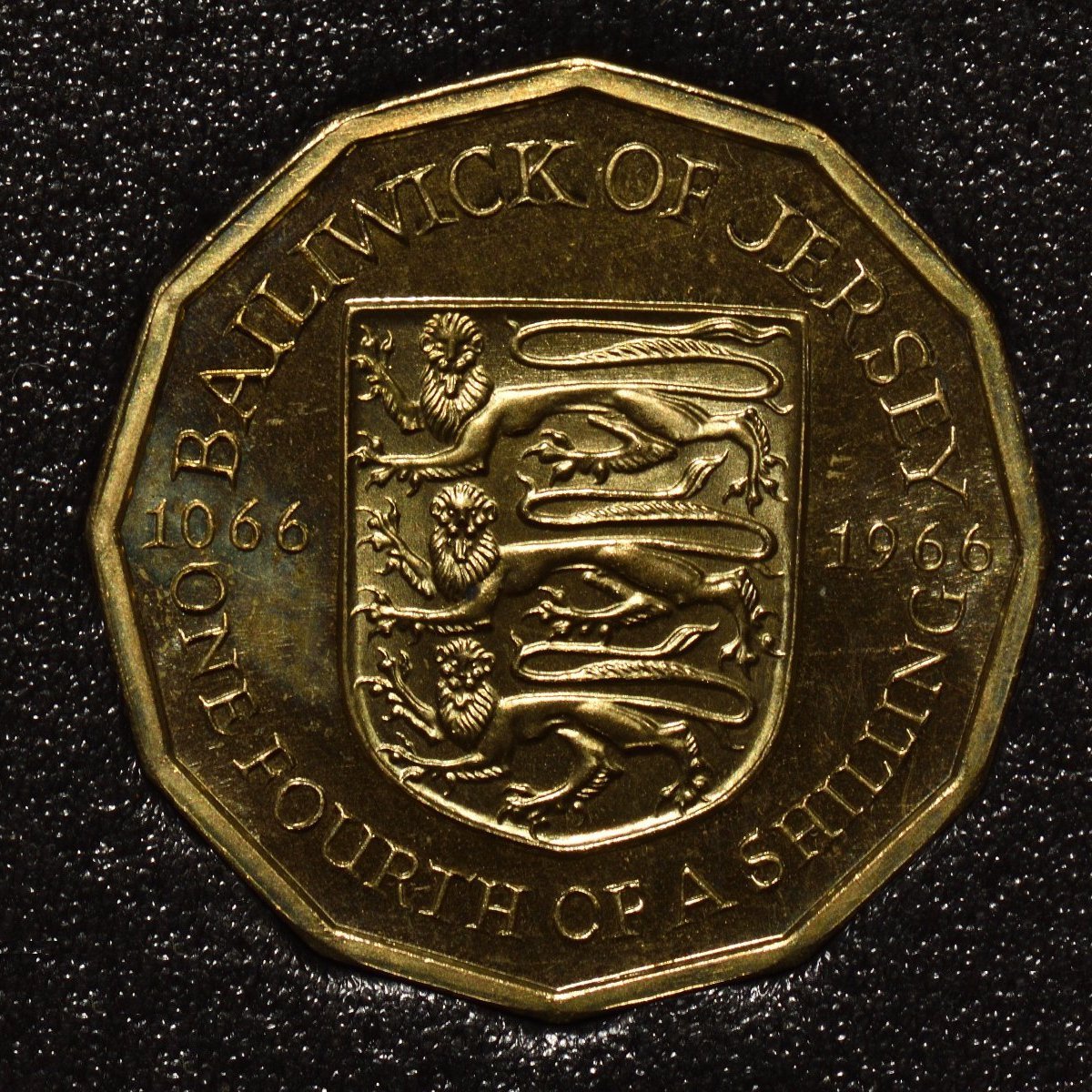 |
Year J# KM# Mintage Diameter
1966 63 27 1,200,000 21.10 
Things to note:
| Five Shillings 1966 Norman Conquest Commemorative (click on image to enlarge) | |
|---|---|
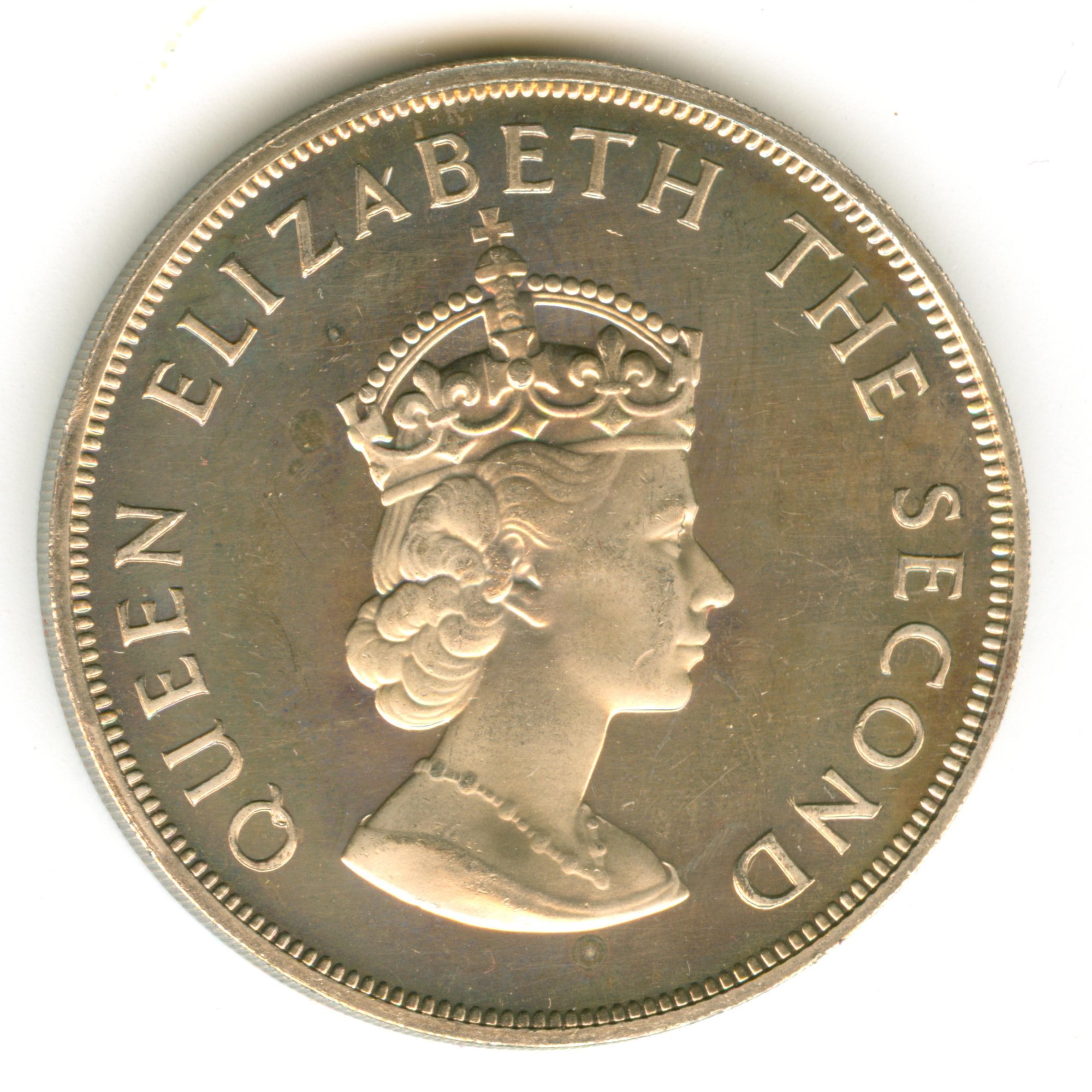 |
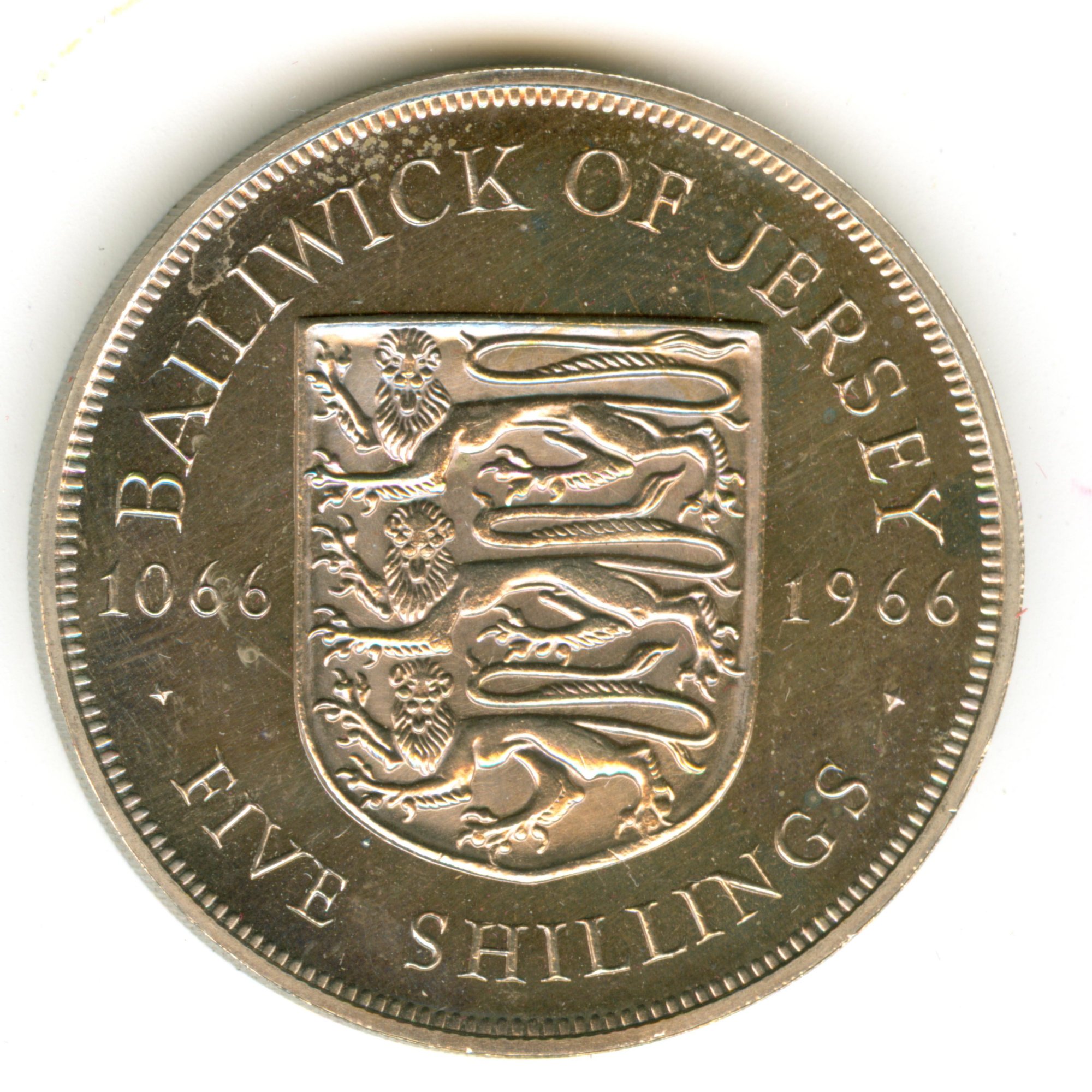 |
Year J# KM# Mintage Diameter
1966 64 28 300,000 38.60 
Of the two designs, the Royal Mint adapted sketch “B” with the two modifications. The first modification was to reverse the positions of “BAILIWICK OF JERSEY” and “FIVE SHILLINGS” so that the former was below the shield and the latter above it. The second modification was to slightly reduce the size of the lettering. The cost of a proof set to the States was 5/- for each coin and 3/6 for the case. Originally, the Mint quoted the States a price of 2/6d for each crown, however the States wanted a “Grade 4” coin versus a “Grade 3.” Per the Royal Mint documents, “It is essential that these proof coins should be acceptable in America, and we are therefore agreeable to them being produced by the former method and are prepared to pay the extra price of 2/6d per coin.”6 In 1967 British dealers were selling the Jersey proof crown set for around £4. The cost of the general circulation issue was £40/10/0 per thousand. These coins were “going so well” that an additional 200,000 pieces were ordered on May 31, 1966. Things to note:
|
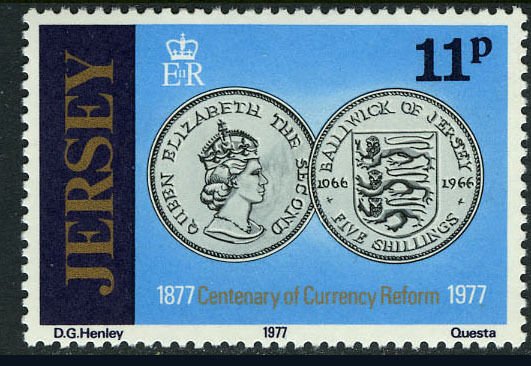 |
| In 1977, Jersey issued this stamp featuring this coin for the "Centenary of Currency Reform." |
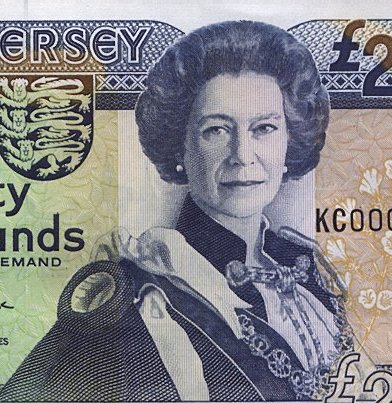 |
Jersey's third set of banknotes uses this portrait, which is copied from a painting by Norman Hepple. The portrait shows Her Majesty's attire in the regalia of the Order of the Garter and was commissioned by the States of Jersey. The original painting hangs in the entrance to the Jersey States Chamber in the States Building, St. Helier, Jersey. |
